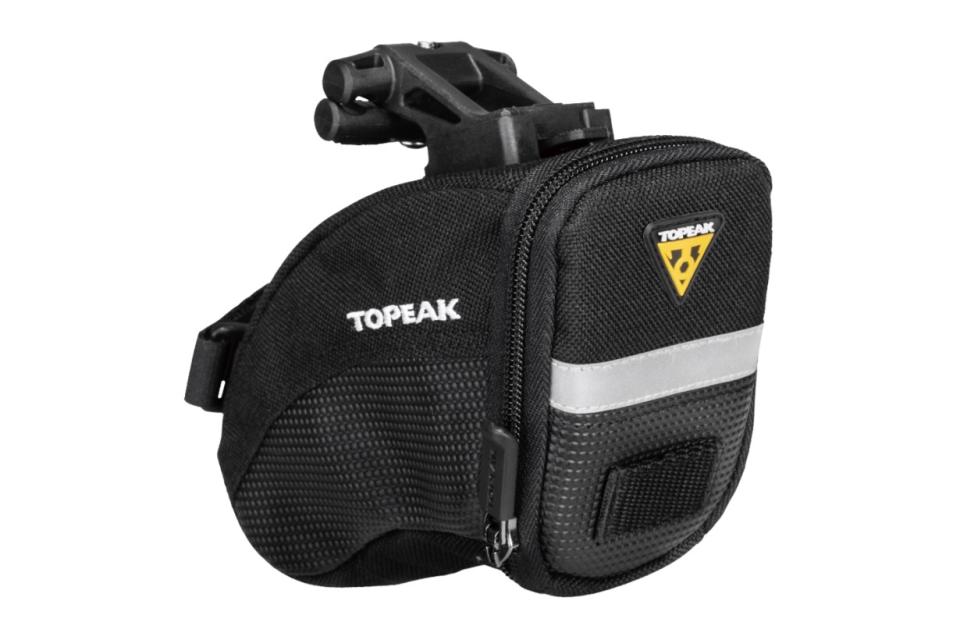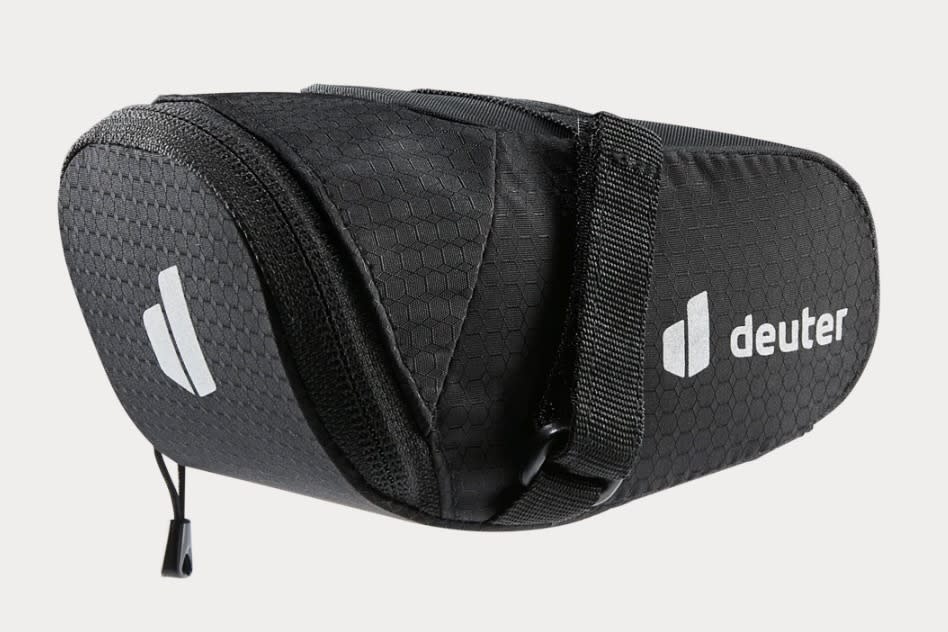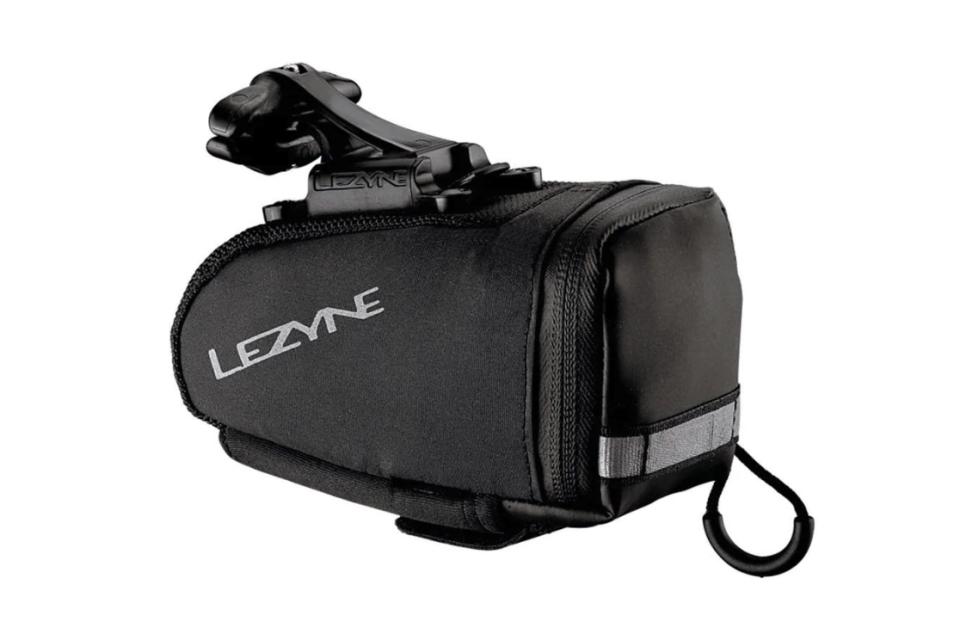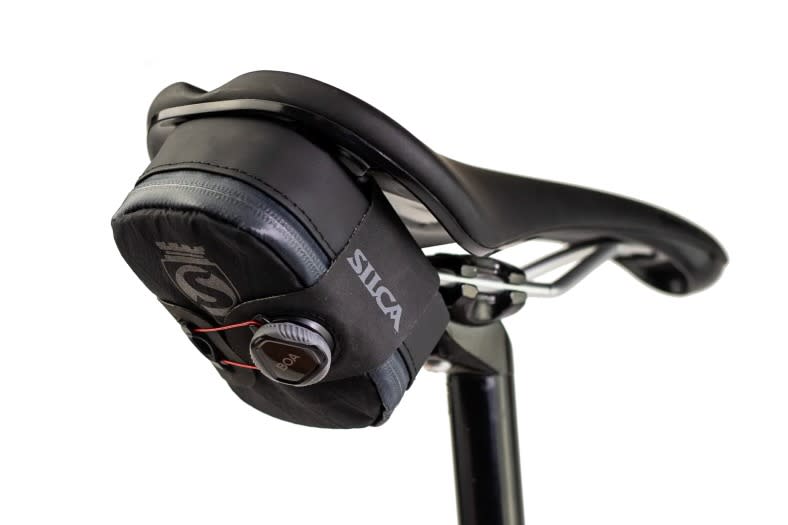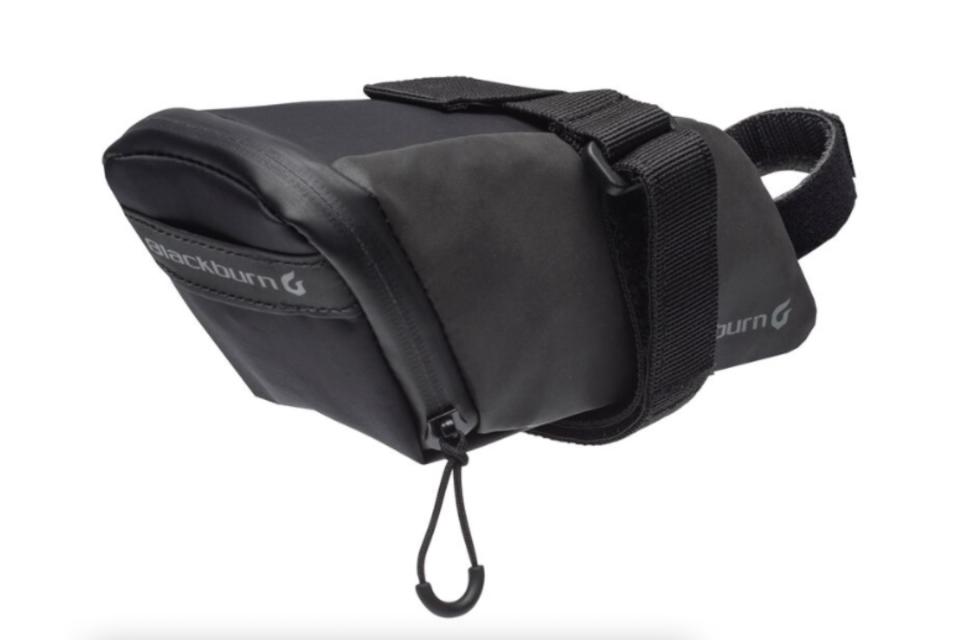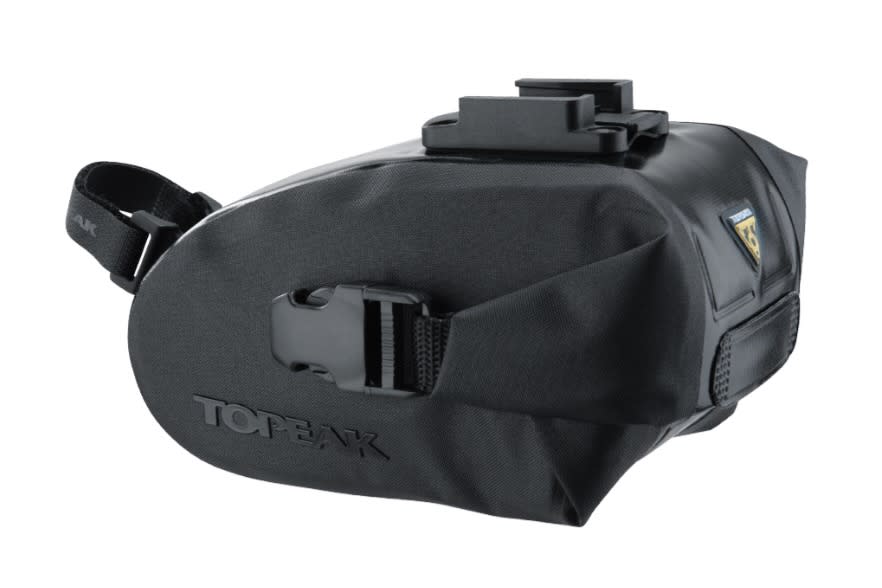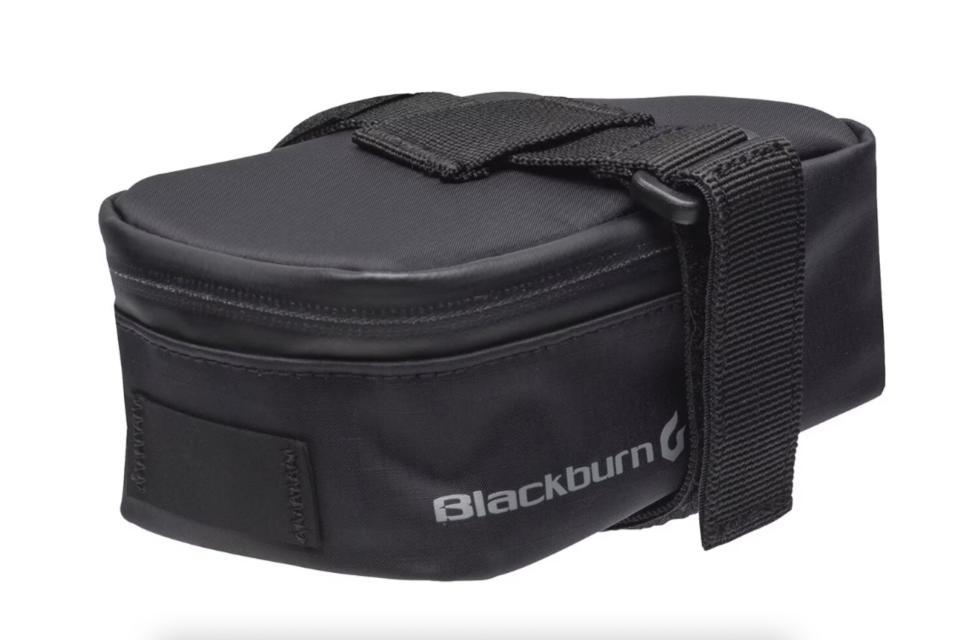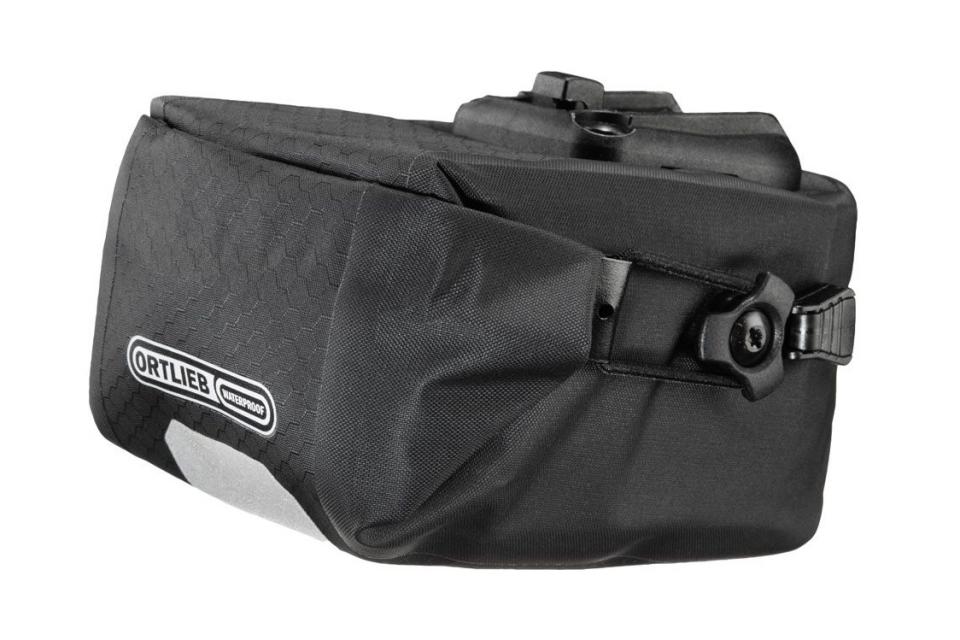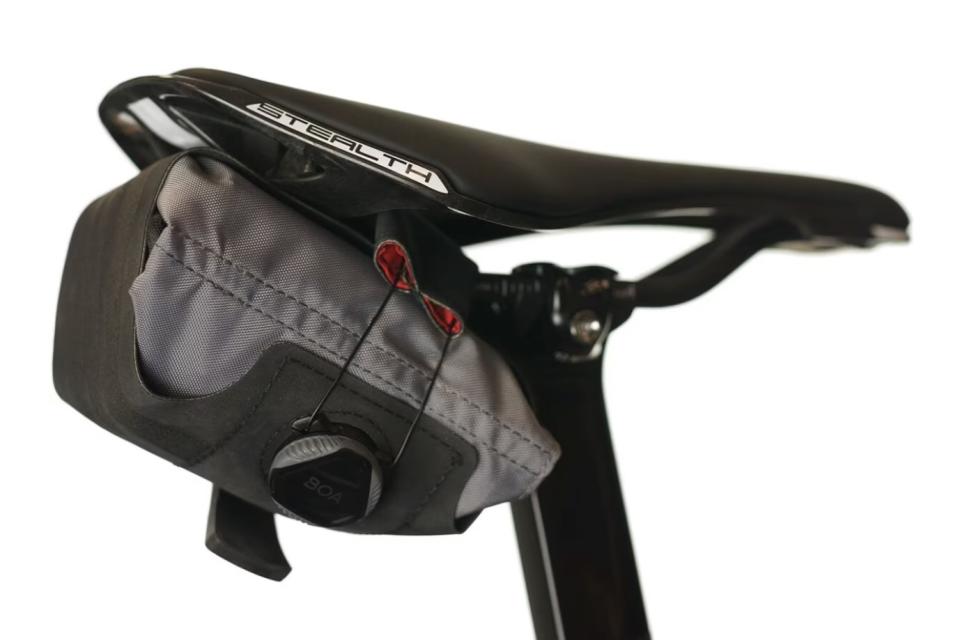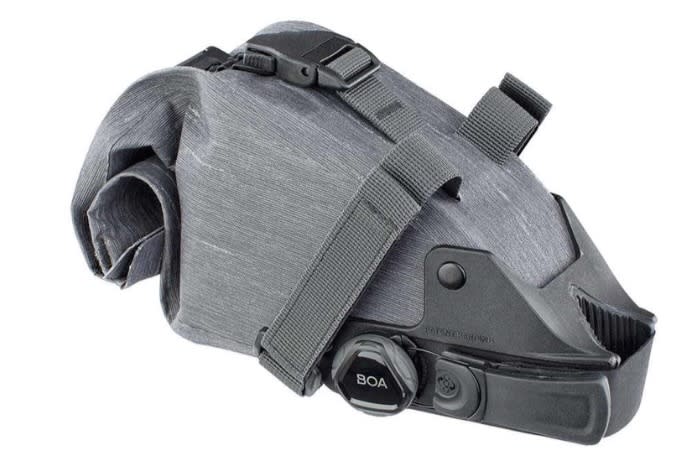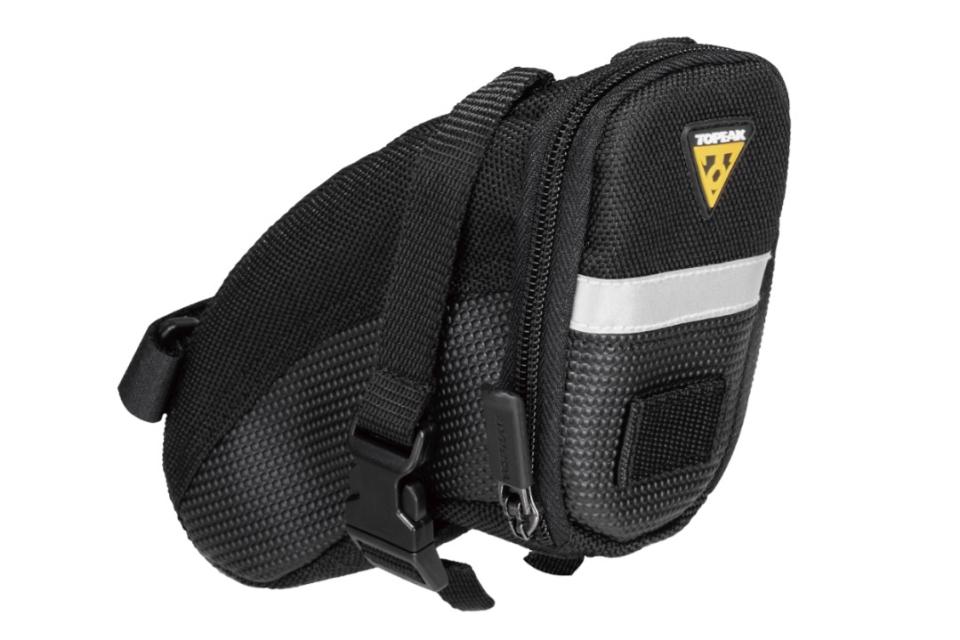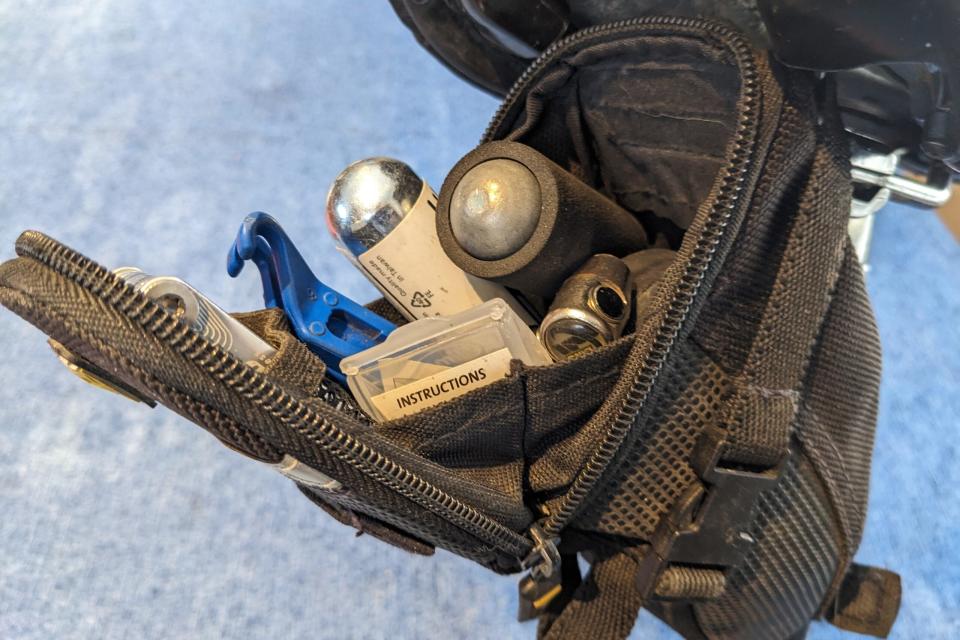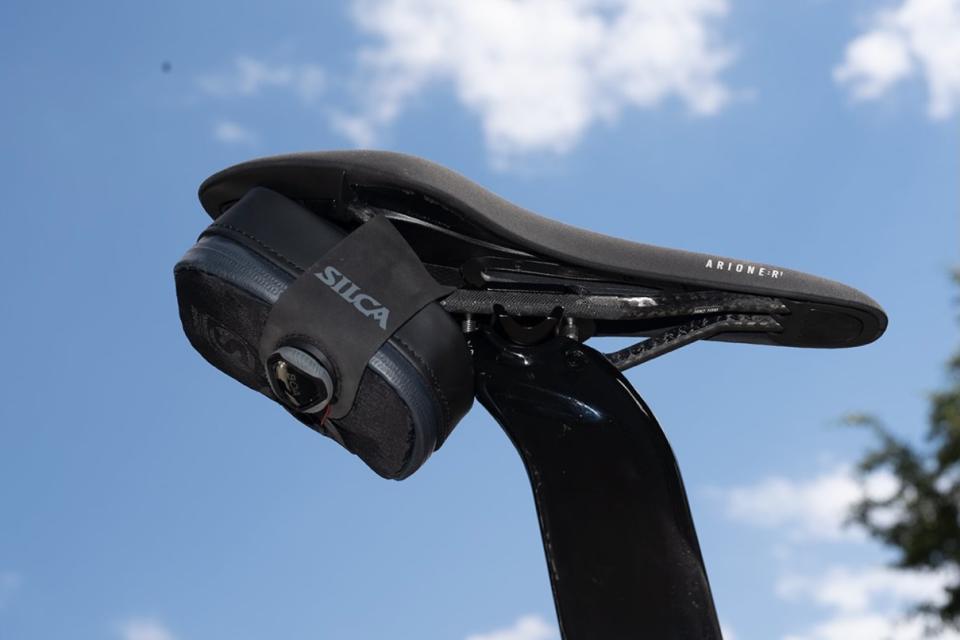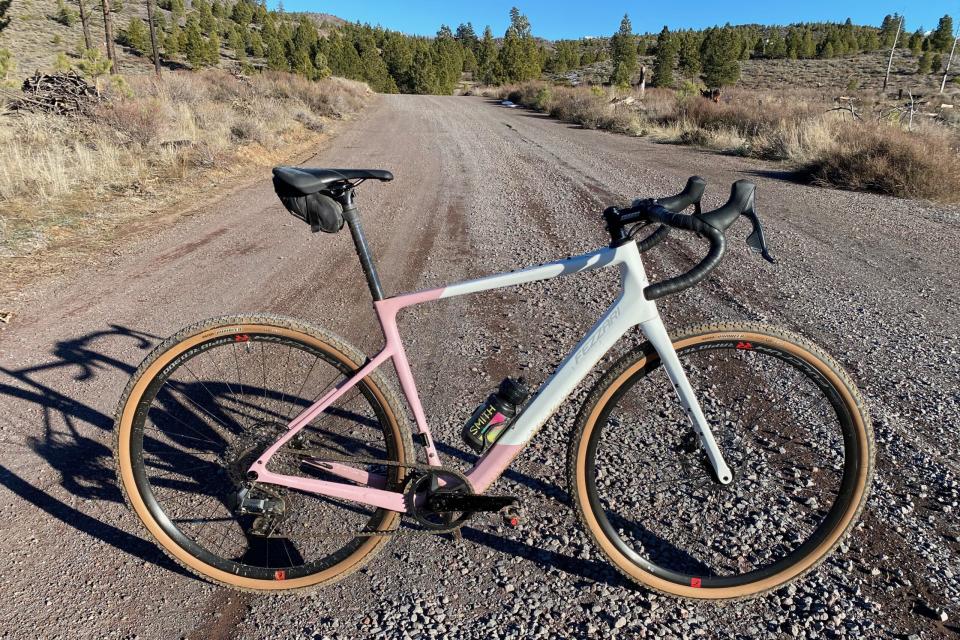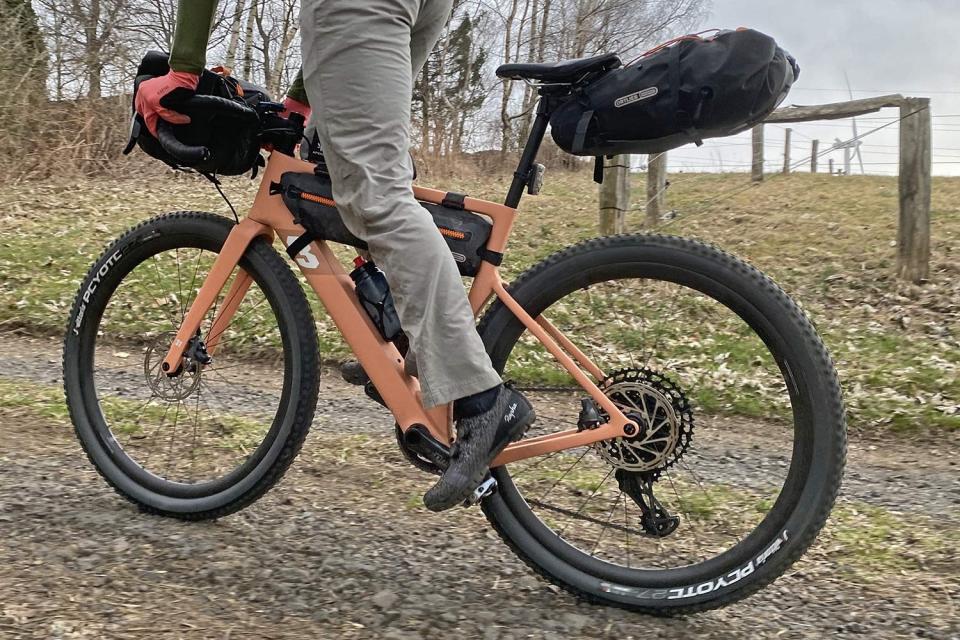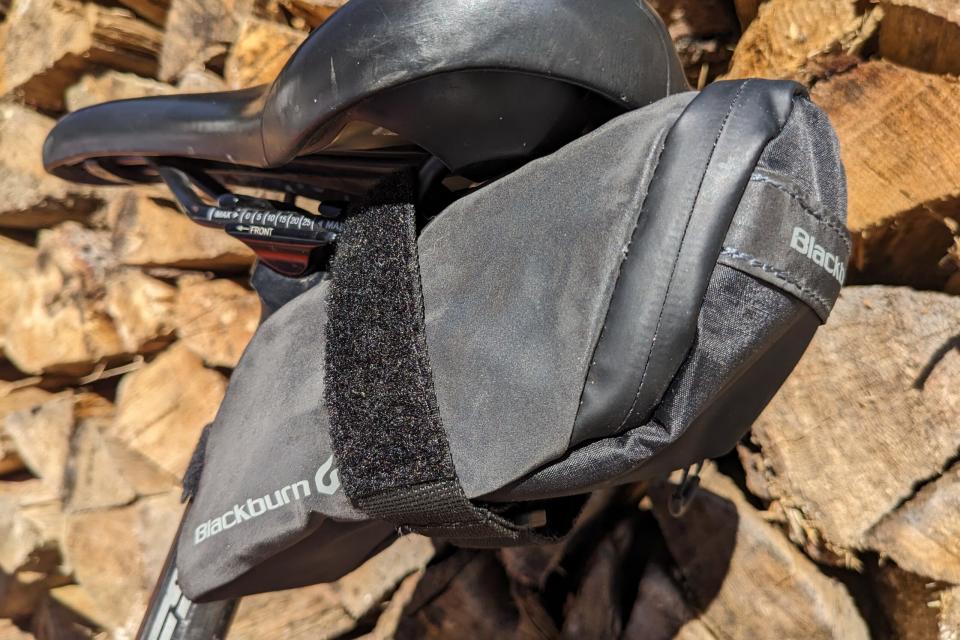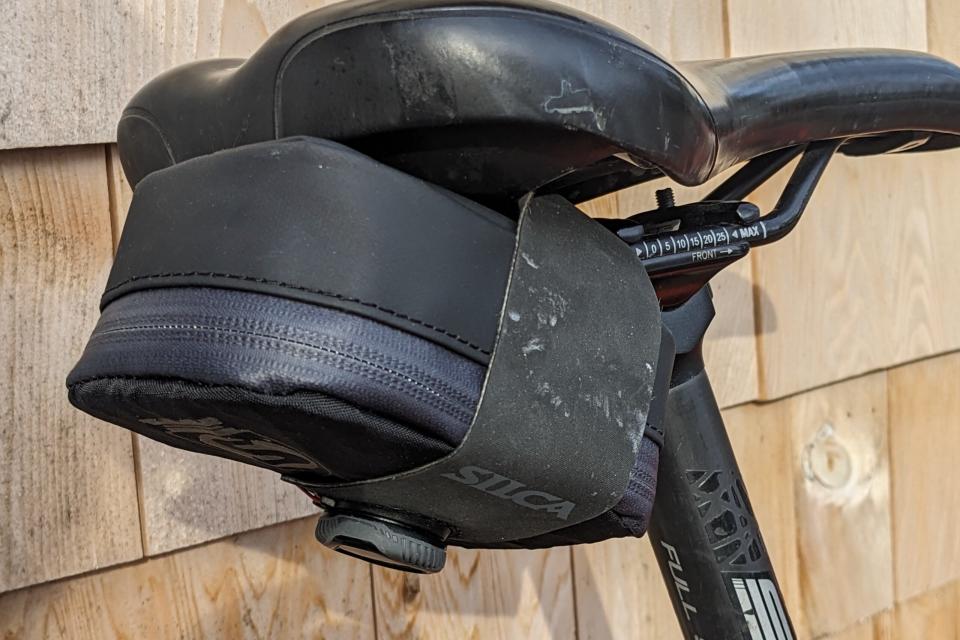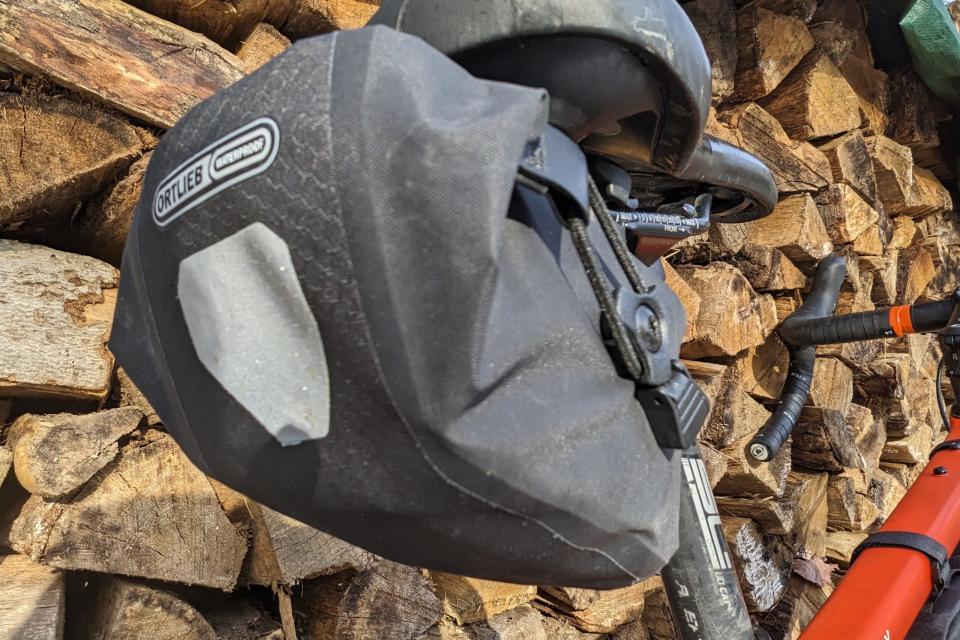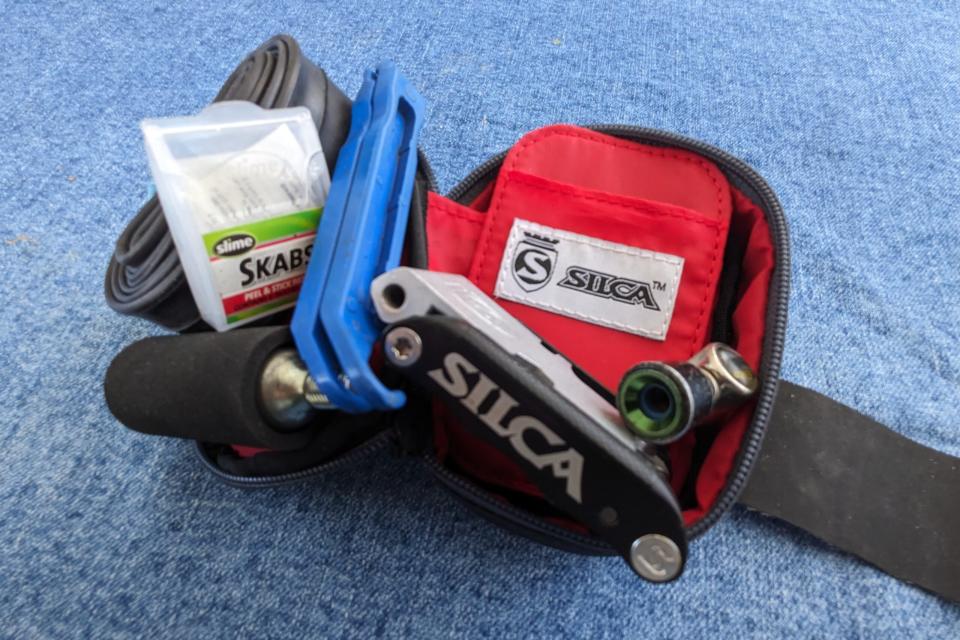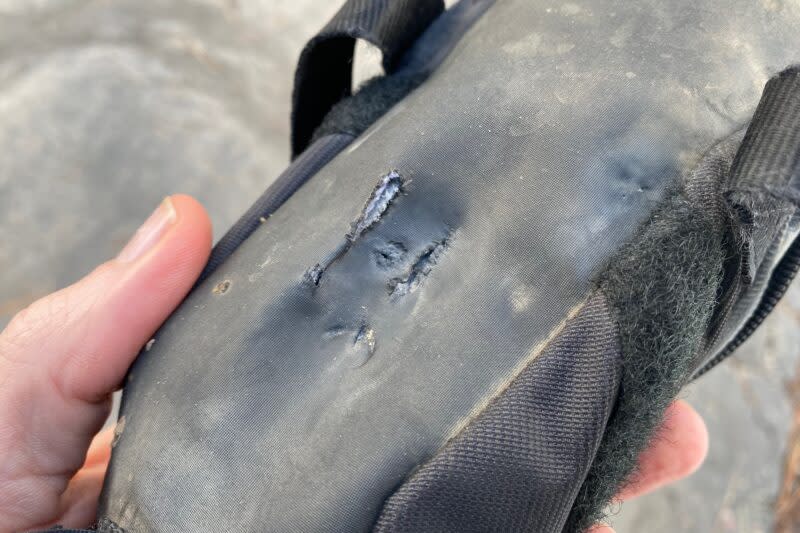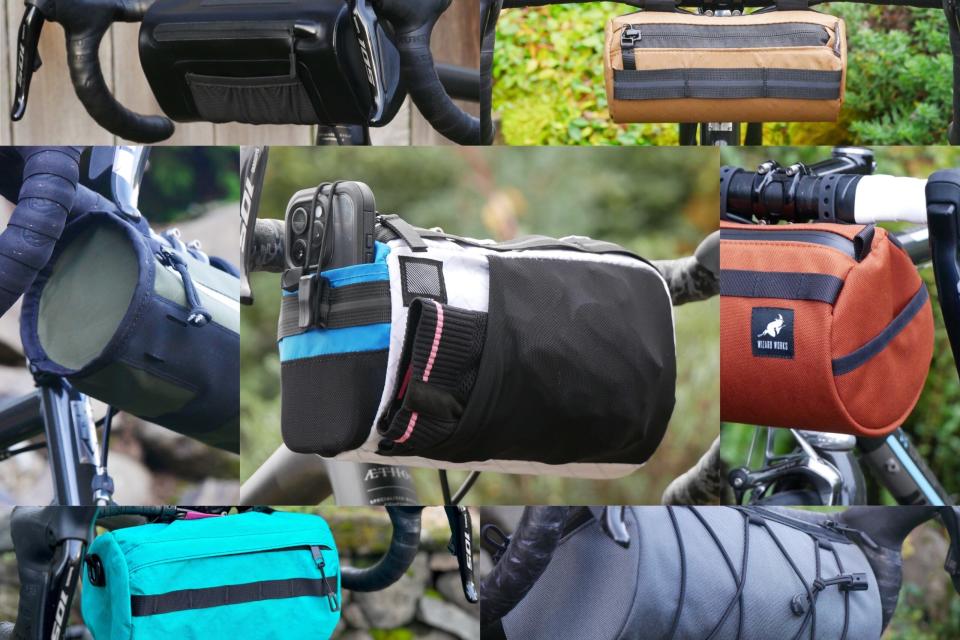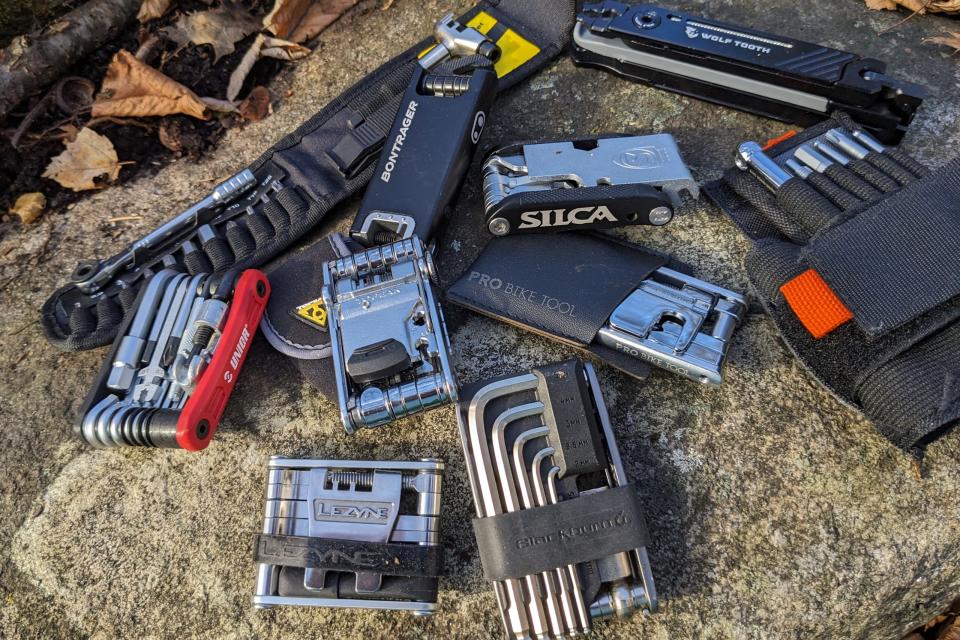The Best Bike Saddle Bags of 2024
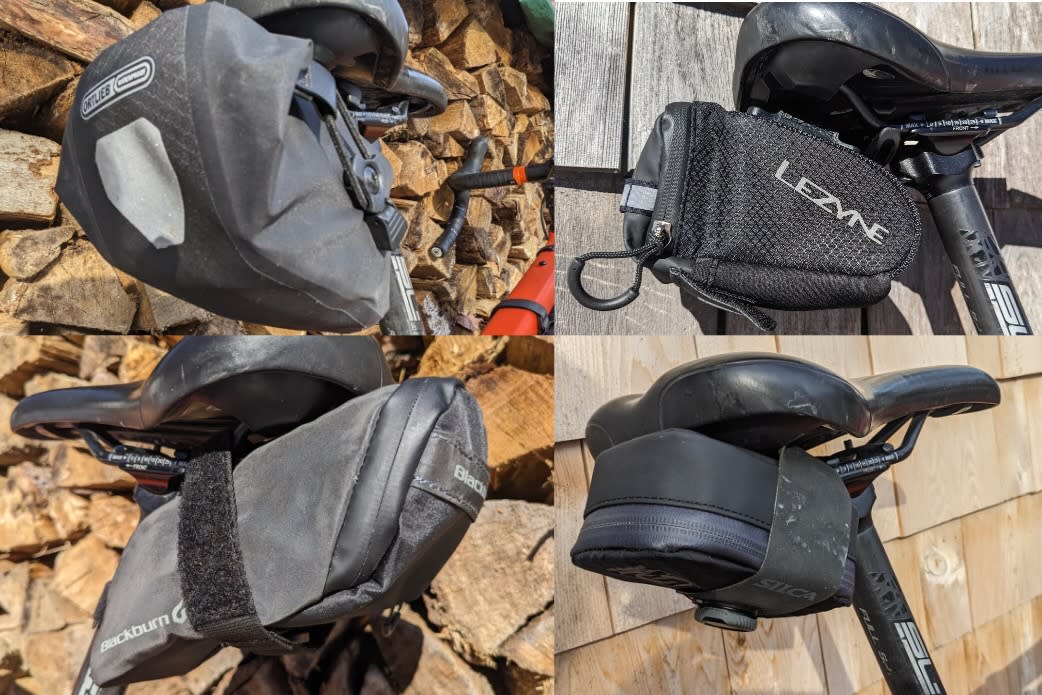
The only time you should have to think much about your bike saddle bag is before you buy it. Pick the right one, and it will sit quietly and securely under your seat and out of the way until you need it. Inside, it will carry the important things you should take on every ride: a multi-tool, and flat repair essentials like a tube, tire levers, inflation, and a few other small, handy items.
The good news is that most saddle bags will work for almost any style of cycling and will fit on the vast majority of road, gravel, and mountain bikes and saddles. What you choose to carry inside will vary, of course, but finding the right saddle bag will keep items out of your jersey pockets and stashed neatly on your bike – keeping you prepared if/when you eventually need them.
But, with so many saddle bags on the market, it can be challenging to choose the right model to suit your specific storage needs. To help, We researched dozens of saddle bags, ranging in size, construction, features, and price, and selected 11 to test and review. Over the course of several months, we analyzed each model’s storage space, layout, attachment system, stability, weather resistance, and ease of use to see how they perform in the real world and compare to each other.
Our top bike saddle bag recommendations for everyday riding are listed below, followed by the best of the rest which are all great options in their own right. Our comparison chart shows all the models we tested at a glance, and if you need help deciding what to choose, our buying advice provides helpful information and you can find answers to common questions in our FAQ section.
The Best Bike Saddle Bags of 2024
Best Overall Bike Saddle Bag: ToPeak Aero Wedge (QuickClick)
Best Budget Bike Saddle Bag: Deuter Bike Bag 0.5
Runner-Up Best Bike Saddle Bag: Lezyne M-Caddy QR
Best Bike Saddle Bag for Road Riding: Silca Mattone Seat Pack
Best Bike Saddle Bag for Reflectivity (and a good value): Blackburn Grid Seat Bag
Best Waterproof Bike Saddle Bag: ToPeak Wedge DryBag
Best Lightweight Bike Saddle Bag: Blackburn Grid MTB
Best Overall Bike Saddle Bag
ToPeak Aero Wedge (QuickClick)
Specs
MSRP $34.95 (Small), price varies by size
Capacity 0.66 L/40 cu. in. (Small)
Dimensions 170 x 120 x 80mm
Weight 105g
Size Options Micro: 0.41 L, Small (tested), Medium: 0.98 – 1.31 L, Large: 1.48 – 1.97 L
Mount Options QuickClick (tested), Strap mount
Pros
Sturdy design
Quick release
Taillight clip
Easy to mount
Available in four sizes
Cons
Small size not for everyone
Not waterproof
The ToPeak Aero Wedge (QuickClick) is a compact, sturdy, smart-looking saddle bag with room to carry all the tools and spares that most cyclists will ever need on a ride. Available in four sizes – extra small, small, medium, and large – we found that the small provides just the right amount of space for the essentials: a spare tube or tubeless tire plugs, tire levers, a multi-tool, a CO2 inflator, and two cartridges. There’s even just enough room to tuck in a car key, cash or credit card, and a few energy bars or gels.
We like to pack our saddle bags tightly because it keeps the contents from jostling around and creating an annoying racket on bumpy roads and terrain. For us, the 0.66 L capacity of the small-sized Aero Wedge hits the sweet spot, holding everything nice and snug. You will want to size up, however, if you like to carry two large mountain bike tubes, but we found that the small can fit two comparatively smaller gravel or road tubes just fine.
It also offers a popular feature on saddle bags these days – a “QuickClick” attachment that makes it easy to remove the bag and take it with you. This is especially helpful if you ever need to leave your bike unattended, where your bag could be a target for theft. (Trust us: It sucks to come out of a coffee shop and find that your bag was swiped.) The quick-release bracket attaches the Wedge firmly to saddle rails with a single hex bolt and keeps the contents from rattling against your saddle rails over bumpy terrain or cracks in the road.
Other features we like: a stiffened opening flap that is designed to avoid spilling contents when it’s unzipped, a mesh pouch on the inside flap for a multi-tool, a car key or spare cash, a reflective stripe across the back, and a rugged, well-sewn taillight clip. Although the ToPeak Aero Wedge isn’t waterproof, that’s not a big issue for us. We’ve found that few bags are fully watertight and that the essentials we typically carry can withstand a little moisture (just remember to dry them out after a wet ride).
Check Price at REICheck Price at Amazon
Best Budget Bike Saddle Bag
Deuter Bike Bag 0.5
Specs
MSRP $18
Capacity 0.5 L
Dimensions 150 x 90 x 80mm
Weight 50g
Size Options 0.5 L (tested), 0.8 L
Mount Options Strap Mount
Pros
Lightweight
Affordable
Made from recycled materials
Cons
No seatpost strap
Deuter may be much better known for their backpacks, but the German brand has been growing its lineup of bike bags for everyday riding and bikepacking. The Deuter Bike Bag 0.5 is one such product that is a simple, effective, lightweight, and very affordable option for adding 0.5 liters of storage under your saddle.
The Bike Bag 0.5 L is incredibly simple with a zippered end flap that opens wide for access to the storage compartment. The 0.5-liter capacity is perfect for stashing your spare tube (maybe two depending on the size), multi-tool, and flat repair items, along with a key and card. It’s made from a lightweight but tough-feeling polyamide fabric that helps keep the weight down to a svelte 50 grams.
The attachment system consists of two nylon webbing straps with hook and loop fasteners that loop through the seat rails and pull the bag up tight under the seat. When fully loaded, we found this system to be adequate for keeping the pack stable, even without an additional seatpost strap. Reflective logos on the back and sides add a touch of low-light visibility.
The beauty of the Deuter Bike Bag 0.5 is its simplicity. It performs the task of securing your essentials to your saddle without fuss and at a low price point that we feel makes it a great value. You won’t find any bells or whistles here, but you will find a product that does what it’s supposed to do while barely impacting your bank account balance.
We also had the chance to use the Deuter Triangle Front Bag 1.5 ($25) which attaches discreetly within the front triangle and adds 1.5 liters of storage. This affordable bag combines nicely with the Bike Bag 0.5 saddle bag to add 2 total liters of storage at just $43 for the pair.
Runner-Up Best Bike Saddle Bag
Lezyne M-Caddy QR
Specs
MSRP $27
Capacity 0.5 L, 30.5 cu. in.
Dimensions 150 x 120 x 70mm
Weight 135g
Size Options One
Mount Options QR: Quick Release, other strap mount options offered
Pros
Big features, small package
Quick release
Rugged
External multi-tool sleeve
Good looking
Cons
Smaller than most
The Lezyne M-Caddy QR is everything you’d want in a compact saddle bag that holds the most common, useful tools and spares in a sleek, aerodynamic package. We loved the ingenious features of this little bag, from its rugged, abrasion-resistant construction to its lightly padded walls and a small external sleeve that securely holds a multi-tool for quick, easy access without needing to unzip the bag.
There are also three internal pockets, one for cash or a car key, the others for tire levers and patches. And it still has room for a spare tube, a CO2 inflator, and a CO2 cartridge; even an energy bar or gel if you pack things tightly. A water-resistant zipper has a large, reinforced pull loop that makes opening it a breeze. A nylon reflective strip on the back holds a taillight and reflective Lezyne logos on the sides provide additional reflective accents for low-light visibility.
The QR (Quick Release) version of this pack has a small bracket that mounts to the saddle rails and the pack itself clips right on for a secure and stable hold. The quick-release allows you to pull it off for easier access or take the bag with you during a mid-ride rest stop, although, at 135 grams, it does add a little bit of weight compared to some of the strap-mount options. Still, with no strap around the seatpost, this bag is impressively easy to install and remove.
This is simply an awesome overall saddle bag, especially for those who pack on the lighter side. At just $27, the M-Caddy QR is a solid value in a thoughtfully designed, small package. Lezyne also makes it in a strap-mount version along with a number of other options in their Caddy line of saddle bags.
Check Price at Jenson USACheck Price at Amazon
Best Bike Saddle Bag for Road Riding
Silca Mattone Seat Pack
Specs
MSRP $50
Capacity 0.4 L
Dimensions 120 x 85 x 40mm
Weight 90g
Size Options Also comes in Mattone Grande (0.74 L)
Mount Options Boa Strap
Pros
Compact
Boa strap secured
Fits close to seat
Easy access
Cons
Relatively small storage volume
More expensive
Although Silca’s Seat Roll Asymmetrico is more of an acquired taste, we think Silca knocked it out of the park with the Mattone Seat Pack, our easy favorite for road cycling that is as functional as it is classy.
With clean lines and a thoughtful, compact design, the Mattone has a smaller, 0.4 L capacity with room for a lightweight road tube or two, tire levers, a multi-tool, and a CO2 inflator. Inside, a nylon divider panel keeps tools separated so that they’re quiet and organized, and the panel itself includes a pocket that’s the perfect size to hold a credit card or car key. The wraparound zipper allows the bag to be opened easily and completely for access to the contents inside. We also like that its narrow profile keeps it from protruding beyond a seat’s edges so that it won’t rub against your cycling shorts.
The Mattone is constructed of water-resistant, ballistic nylon, which, along with the YKK Aquaguard zipper, will fend off showery rain and light road spray. The whole package is wrapped by a wide Hypalon strap to keep it secure and attach easily to saddle rails, and is tightened with a Boa closure system that is far stronger than traditional hook-and-loop straps. While strong and easy to operate, the Boa attachment system and opens-like-a-book style of the pack make it so the whole thing basically needs to be removed to access the contents, however. That said, it’s quick and easy to do with the Boa strap.
The Silca Mattone Seat Pack is a great-looking saddle bag that will complement any bike from high-end road machines to rugged gravel crushers. At $50, it’s on the more expensive end of the spectrum, but like other Silca products, the Mattone is built to last with excellent craftsmanship, quality materials, and a great design. Silca also sells the Mattone Grande (0.74-liter) for those who need a little more storage.
Find out more in our launch coverage of the Silca Mattone Seat Pack.
Check Price at REICheck Price at Silca
Best Bike Saddle Bag for Reflectivity (and a good value)
Blackburn Grid Seat Bag (Medium)
Specs
MSRP $30 (Medium), varies by size
Capacity 0.8 L
Dimensions 177.8 x 82.5mm
Weight 70g
Size Options Small: 0.4 L, Medium (tested), Large: 1.9 L, MTB: 0.4 L
Mount Options Strap Mount
Pros
Reflective side panels
Water resistant
Narrow profile
Light for its size
Zip pullcord
Cons
Lacks quick-release
Hook-and-loop straps
The Blackburn Grid Seat Bag is a basic and rugged all-arounder that will suit most riding styles, and reliably carry your gear in all conditions. Blackburn even backs it up with a lifetime warranty, which makes the Grid a hard bargain to beat.
The 0.8 L capacity (medium) size we tested has room for two road or gravel tubes or one mountain bike tube, a multi-tool, two tire levers, and an inflator with a spare cartridge, along with space to tuck in a car key and some nutrition. It is lightly padded throughout which helps keep things from jostling around, a lighter-colored material inside makes finding items easier, while a small internal pocket fits most multi-tools.
We also like the corded pull tab on the zipper, which makes opening the bag easy, even with insulated, full-fingered gloves and in poor lighting. The opening flap prevents contents from spilling, and it has a nice taillight clip across the back. One thing that stands out about the Blackburn Grid is its reflectivity, with both side panels and a stripe on the back that look normal in broad daylight but light up in headlight beams. This adds significant visibility in low-light conditions both from behind and on the sides.
The Grid attaches with two simple hook-and-loop straps, one for the seat post and the other for the saddle rails. Although it is not quick-release, we like how the straps allow the Grid to be fitted snuggly under virtually any saddle. However, we’ve also found that hook-and-loop straps can become worn and lose some of their holding power over time, so check to make sure they’re secure and solid before each ride.
The standard Blackburn Grid Seat Bag comes in 3 sizes so you can find one that meets your storage demands. It also comes in a small, “MTB” version with a slightly different shape and layout. And, at $30 (size medium), it’s an affordable option that’ll reliably hold your essential gear until you need it for years to come.
Check Price at BackcountryCheck Price at Amazon
Best Waterproof Bike Saddle Bag
ToPeak Wedge DryBag
Specs
MSRP $52.95 (Medium)
Capacity 1 L, 61 cu. in.
Dimensions 185 x 115 x 110mm
Weight 170g
Size Options Small: 0.6 L, Medium (tested), Large: 1.5 L
Mount Options QuickClick (tested), Strap Mount
Pros
Waterproof
Capacity
Rigid sidewalls
Secure closure
Quick release
Multiple size options
Cons
Access to inner pockets
More expensive
Heavier weight
The ToPeak Wedge DryBag is a great bag for any ride, but we give it top honors for its water resistance because of its sturdy, waterproof materials and roll-top design. We tested the 1-liter capacity (medium) size and found it was ideal for riding off-road, with plenty of space to hold a beefy 29-er tube, tubeless tire plugs, multi-tool, inflator with several cartridges, along with an energy bar or two, and more.
Compared to many of the smaller capacity bags we tested the 1-liter volume of the medium Wedge DryBag feels cavernous but it accommodates larger, or multiple, tubes easily. Depending on what you carry, one might even be able to stuff a light, packable jacket inside. Thankfully, it also comes in small (0.6-liter) and large (1.5-liter) sizes, so most riders should be able to find a size that meets their storage needs depending on discipline or length of ride.
This bag handles nasty conditions well, protecting your gear from mud, water, and even slushy snow; and its rigid, sonic-welded, and seam-sealed waterproof shell sheds moisture easily. Two interior mesh pockets help to keep things organized, although we found them hard to see into and access inside the deep, all-black interior. The roll-closure is secured with both Velcro and plastic buckles to keep it cinched down over the roughest terrain. A taillight clip on the back and a reflective stripe add visibility to help you be seen in challenging light conditions.
The QuickClick attachment prevents the bag from bouncing and also allows you to quickly remove the Wedge DryBag and take it with you, making this a nice option for mountain, gravel, or bikepacking adventures with stops in civilization along the way. ToPeak also makes this saddle bag with a more traditional strap mount that looks otherwise identical in terms of design.
Check Price at BackcountryCheck Price at Amazon
Best Lightweight Bike Saddle Bag
Blackburn Grid MTB
Specs
MSRP $20
Capacity 0.4 L
Dimensions 140 x 51mm
Weight 31g
Size Options One size for "MTB" version, 3 other sizes of regular version
Mount Options Strap Mount
Pros
Simple, functional
Super lightweight
Interior pocket
Affordable
Cons
Small capacity
Hook-and-look strap
As its name suggests, the Blackburn Grid MTB is a fine, compact bag for mountain biking, but we think its real sweet spot is actually for road or gravel cycling when you’re apt to carry a lighter load, with a smaller tube than you would on a rugged mountain bike excursion. Blackburn says it features, “Just the basics. No more. No less,” and that’s evident in its simple design and super light, 31 grams, weight.
That’s a beautiful thing because saddle bags are inherently simple pouches that hold a few essentials under your saddle. This water-resistant bag is made of strong, lightly padded nylon, with a water-resistant zipper and a single interior pocket for storing cash, a credit card, or a car key. It is the lightest bag we tested, yet will still hold a multi-tool, a spare tube, and a flat repair kit along with an energy bar or gel in its 0.4 L compartment.
The single hook-and-loop closure strap fits easily on most saddle rails and allows it to be snugged up tightly under the seat. We found the hook-and-loop closure works fine, however, Blackburn cautions against overloading the bag or leaving it on your car rack while driving.
The Blackburn Grid MTB has a lighter-colored interior to help identify your items more easily and outside it has reflective logos and a tail light clip. Like other Blackburn products, it’s covered by a lifetime warranty, and at $20, is an affordable way to add a small amount of storage to any type of bike.
Best of the Rest
Another Great Waterproof Option
Ortlieb Micro Bag Two
Specs
MSRP $45 (0.8 L)
Capacity 0.8 L
Dimensions 140 x 120 x 90mm
Weight 140g
Size Options 0.5 L, 0.8 L (tested)
Mount Options Quick Release
Pros
Lightweight
Good capacity
Waterproof
Quick release
Cons
No taillight clip
Lacks inner pockets
Like other models we tested, the Ortlieb Micro Bag Two would certainly be a fine bag for all types of riding, but we found it to be particularly great for rides on dirt. Across the huge range of conditions that define off-pavement riding, you’ll appreciate a bag that’s waterproof, easy to open, lightweight, and quick to remove from your bike. One with ample room for all the usual tools, including a spare tube, plugs, an inflator, plus a tire boot, master chain link, your wallet, a set of keys, bars and gels, and a few other knickknacks.
With 0.8 liters of capacity, the Micro Two is up for the job. Incredibly light for its size, it’s also remarkably sturdy and waterproof, and the roll-up opening provides quick access while keeping moisture at bay. While it does not have inner organizing pockets, the wide opening makes finding things so easy that it wasn’t an issue for us. It also comes in a smaller, 0.5-liter size for those who carry a little less on their rides.
We really like the quick-release seat bracket, which feels solid in hand, quiet on the bike, and makes it super easy to remove from the bike when needed. The bag’s only drawback is that it does not have a taillight clip, although it does have a large patch of reflective material on the back.
So, as long as you can mount a taillight on your helmet, seat post, or elsewhere on your bike (or you don’t use one at all), the Ortlieb Micro Bag Two is an excellent choice for gravel, bikepacking, road riding, or commuting where you want to keep your contents protected from the elements and you need a bit more room than a small saddle bag provides.
Unique Tool Roll Style
Silca Seat Roll Asymmetrico
Specs
MSRP $50
Capacity Variable
Dimensions Variable: "Hold tubes up to 700x45mm"
Weight 85g
Size Options One
Mount Options Boa Strap
Pros
Super compact
Adjustable
Lightweight
Snug fit to seat
Organization pockets
Cons
Cumbersome to pack
Must remove from seat to access contents
Designed to hold just the bare essentials in a compartmentalized fashion, seat rolls are an interesting alternative to consider, especially if you’re a minimalist who mostly rides on the roads. Unlike a bag, rolls hold tools and spares in pockets sewn onto a flat piece of sturdy fabric, which is then folded and rolled up snuggly to fit closely against your saddle.
The Silca Seat Roll Asymmetrico is well-made, with four pockets that have room to store a lightweight inner tube (Silca says it will hold up to 700x45mm, although we found that made the roll feel bulky), two tire levers, a small multi-tool, a CO2 inflator, and one or two CO2 cartridges. Wide rail guards protect your saddle from rubbing, and the Boa closure allows it to be tightened for a super compact, snug, and stable fit under the seat. Although it felt secure on smoother surfaces, it can move around a bit over rough terrain, particularly if it isn’t full or attached tightly enough.
Rolls have plenty of loyal fans, but they’re an acquired taste. Comparatively speaking, they are a bit more cumbersome and time-consuming to deal with because accessing them usually means removing them from your bike, unfolding the entire roll to reach a tool, and remounting it when you’re finished. That’s a lot more steps than unzipping and closing a saddle bag and certainly not the most time-efficient option if you’re in the middle of a race or something. Silca even offers a helpful how-to video for the roll, which suggests how befuddling these can be for new users.
Regardless, if you get along with the seat roll style and prefer to have your items separated into organizational compartments, the Silca Seat Roll Asymmetrico is a solid option to consider. At $50, it’s a bit of a splurge, but it’s made with excellent attention to detail and quality materials and should last you for many seasons out on the road.
You can read more in our launch coverage of the Silca Seat Roll Asymmetrico.
Check Price at REICheck Price at Silca
EVOC Seat Pack Boa
Specs
Price $110
Capacity 1 L
Dimensions 220 x 100 x 100cm
Weight 198g
Size Options Small (tested), Medium: 2 L, Large: 3L
Mount Options Boa and Hook and Loop Straps
Pros
Waterproof
Sturdy
Dropper post compatible
Capacity
Cons
Single strap closure
Heavy
Expensive
The Evoc Seat Pack Boa is nearly identical to the Topeak Wedge DryBag mentioned above in size and function, with a few differences that are worth noting. The 1-liter capacity of the size small is on the larger side for most daily rides but offers ample storage for larger mtb tubes or an extra layer. The larger sizes, 2 and 3 liters, are geared more towards overnight bikepacking adventures where you want significantly more storage space.
The Seat Pack Boa is solidly built and waterproof, with rigid side panels and a wide, roll-closure opening. The roll-top closure has a single clasp, however, which requires more fiddling to roll up and close the bag tightly. When it was closed, the opening’s edges protruded well beyond the walls of the bag, which gave it a somewhat awkward, less streamlined look.
Yet, we like the old-school hook-and-loop nylon straps that make it easy to fit onto virtually any saddle. A solid plastic seatpost contact works well with both rigid and dropper posts, and the strong Boa retention system secures it to the post.
The Evoc Seat Pack Boa’s rugged design held firmly to our mountain and gravel bikes through nasty conditions, although it tended to bounce around a bit on very bumpy rides unless we were extra careful to cinch it down tightly beforehand. Once you dial in the fit, however, it’s a nice bag that will go the distance in any weather, assuming the larger 1-liter size suits your needs.
Find out more in our coverage of EVOC’s Boa-equipped bike bags.
Check Price at BackcountryCheck Price at Amazon
ToPeak Aero Wedge (Strap Mount)
Specs
MSRP $29.95 (Small), varies by size
Capacity 0.66 L, 40 cu. in.
Dimensions 180 x 110 x 85mm
Weight 100g
Size Options Micro: 0.41 L, Small (tested), Medium: 0.98 L, Large: 1.97L
Mount Options Strap Mount (tested), QuickClick
Pros
Easy to fit and adjust
Mesh inner pouch
Great value
Also sold in Quick Release version
Multiple size options
Cons
Lacks quick-release
Not waterproof
The ToPeak Aero Wedge (Strap Mount) represents a solid value for a sturdy, aerodynamic saddle bag that will serve most riders for day-to-day use, and also fit virtually any bike. Available in extra-small, small, medium, and large sizes, the small (0.66 L) version has plenty of room for the most useful tools and spares you’ll want on most daily rides.
While it’d be tempting to call this a no-frills bag, it has some thoughtful, extra touches: a large zipped opening that makes accessing tools easy, a stiff opening flap that prevents items from falling out when opened, a mesh pouch on the inside flap to hold a multi-tool, energy gel or emergency cash; a reflective strip across the back and a strong, well-made light clip that will hold a rear light securely.
In fact, this budget pack is identical to our top-rated overall bag, the Topeak Aero Wedge (QuickClick), except that it has adjustable straps that attach it to your seat rails. While they may look a little old-school, we love how these kinds of straps make it easy to dial in a nice, tight fit under your saddle and the plastic buckles keep it relatively quick to attach and remove.
Overall, the ToPeak Aero Wedge (Strap Mount) is a solid saddle bag that’s reasonably priced and will keep your essentials handy and out of your jersey pockets. It’ll fit on virtually any bike or saddle, and the 4 size options give you the ability to choose the right size to suit your storage needs.
Check Price at Jenson USACheck Price at Amazon
Comparison Chart
Saddle Bag Model | MSRP | Capacity | Dimensions | Weight | Mount Type |
|---|---|---|---|---|---|
$34.95 | 0.66 L (Small) | 170 x 120 x 80mm | 105g | QuickClick | |
$18 | 0.5 L | 150 x 90 x 80mm | 50g | Strap Mount | |
$27 | 0.5 L | 150 x 120 x 70mm | 135g | Quick Release | |
$50 | 0.4 L | 120 x 85 x 40mm | 90g | Boa Strap | |
$30 | 0.8 L (Medium) | 177.8 x 82.5mm | 70g | Strap Mount | |
$52.95 | 1 L (Medium) | 185 x 115 x 110mm | 170g | QuickClick | |
$20 | 0.4 L | 140 x 51mm | 31g | Strap Mount | |
$45 | 0.8 L | 140 x 120 x 90mm | 140g | Quick Release | |
$50 | Variable | Variable | 85g | Boa Strap | |
$110 | 1 L | 220 x 100 x 100mm | 198g | Boa and Straps | |
$29.95 | 0.66 L (Small) | 180 x 110 x 85mm | 100g | Strap Mount |
Why You Should Trust Us
With a serious affinity for riding bikes of all kinds, the team at Bikerumor is always searching for the best ways to carry the essentials with us on all of our rides. While on-bike storage is constantly evolving, the humble saddle bag is still one of our favorite ways to ensure that we have our ride essentials at the ready on our rides. We love the set-it-and-forget-it aspect of saddle bags, where our tools and flat repair items are waiting patiently until we need them. We also know that having so many options to choose from can make it harder than you might expect to find exactly what you need.
For our bike saddle bags buyer’s guide, we rounded up a selection of 11 different models to test and compare side by side. Review author, Jim Graham, tested all of the bags in this review to see how they perform out on the road or trail, and how they compare to each other. Jim is an avid outdoorsman who lives in southern New Hampshire where he splits his time between cycling, trail running, and coaching a Nordic ski team in the winter months. While he enjoys all types of riding, in recent years, he’s taken a shine to gravel riding and loves going out exploring the wealth of country roads and rail trails accessible from his home, as well as participating in some long-distance cycling events. He also likes to be prepared on his rides, and he’s been using saddle bags for decades to keep his essential gear on the bike to deal with flat tires and other mechanical issues. Jim is enjoying semi-retirement, which gives him even more time to get out and ride and test gear. In addition to this review, Jim has contributed to Bikerumor’s guides of the best gravel biking tires and our favorite bike multi-tools.
After researching the best saddle bags on the market, we gathered a diverse selection of 11 models for testing and comparison. After a close inspection of each bag’s materials, construction, and layout, we packed each one up, mounted it to our test bike, and headed out for numerous test rides to see how they performed in the real world. In the process, we analyzed the ease of attachment, storage space, stability, ease of opening, closing, and removing items, and special features like organization pockets, reflective elements, tail light clips, and water resistance. After installing, removing, and loading/unloading each saddle bag countless times, we zeroed in on our favorites and those that excel in specific ways compared to the rest.
Buying Advice: How to Choose a Bike Saddle Bag
With so many brands, models, and sizes on the market, it’s easy to get lost comparing specs and details when you’re shopping for a saddle bag. And you have to wonder: Are all those options really necessary, or even worth worrying about?
The truth is that most saddle bags will work well enough across the huge range of cycling styles and fit the vast majority of bike saddles and bicycles. And they will hold the most important essentials that every cyclist should bring on every ride. Depending on your riding style, what you choose to carry in a saddle bag, attachment style preference, and need for water resistance, you should be able to narrow down the choices to find seat pack that perfectly suits your needs.
What Type of Riding Are You Doing?
What you carry with you, and therefore, how much storage you need may vary depending on whether you’re riding road, gravel, or mountain bikes. Here are some guidelines for matching a bag to the type of riding you’re doing, based on our experience, but bear in mind that this may vary depending on what you like to bring with you on a ride and how much of it you want to put in a saddle bag.
Road
For road cycling, we’re typically minimalists. Give us a small, lightweight bag with just enough room for a simple multi-tool, tire levers, a spare tube, a tire patch or two, and a car key. Most small saddle bags will also fit a CO2 inflator and cartridge or two, but it’s not a deal breaker for us if we need to mount a mini pump to our frame. Since road tubes are generally pretty small, all this can typically squeeze into small-capacity saddle bags like the Silca Mattone Seat Pack (0.4-liter), Blackburn Grid MTB (0.4-liter), or the Lezyne M-Caddy QR (0.5-liter).
Mountain
Although the use of saddle bags is a bit less common on modern mountain bikes than it used to be, many riders still choose them as their preferred method for adding some on-bike storage. Riding trails can be harder on your bike, and you’re more likely to be farther away from any place where you can get help, so you’ll want to pack gear that covers a wider range of repairs and adjustments. The basics include a robust, full-featured multi-tool, spare tube (or two), tire levers, a CO2 inflator, and a couple of CO2 cartridges. (Inflators make it much easier and faster to fill a large-volume mountain bike tire than a mini pump.) It’s also wise to carry a quick link to fix a broken chain, tubeless tire plugs, a spare derailleur hanger, perhaps extra tire sealant, and a small first aid kit. A bit of duct tape can’t hurt either!
Since mountain bike tubes are much larger than road or gravel tubes, you need a little more space in a saddle bag to fit them. Some of the larger and mid-sized bags we tested, like the Blackburn Grid (medium), Ortlieb Micro Two, ToPeak Wedge DryBag, and the EVOC Seat Pack Boa are capable of fitting a slightly larger load, and the latter three of those claim to be waterproof as well.
It is important to mention, however, that on modern full-suspension mountain bikes with dropper posts, rear tire clearance can be an issue. You’ll want to check and make sure that a saddle bag won’t conflict with your rear tire when the rear suspension is compressed and that it works with your dropper post (if you have one). For this reason and others, many mountain bikers will opt to carry their gear in a quality hip pack or hydration backpack.
Gravel
For gravel riding, we like a saddle bag that’s somewhere in between. We find that mid-ride stops for repairs and adjustment are generally less frequent and serious than in mountain biking. On the other hand, gravel rides usually require more frequent pitstops than road rides. For this reason, we like a mid-sized bag that’s not as bulky or heavy as one we’d use for mountain biking, but which will also carry a little more gear than we would on the road, especially a master chain link and a spare tube or two. Depending on what you put in your saddle bag, some of the small capacity options could work well, but something with a medium capacity, like the ToPeak Aero Wedge (0.66-liter, size small), makes it a little easier to squeeze in slightly larger gravel tubes and/or extra CO2 cartridges.
Bikepacking
Overnight or multi-day adventures require significant amounts of storage space to carry things like sleeping bags, jackets, cooking gear, etc. Thankfully, there is a growing number of brands putting out amazing saddle, frame, and handlebar bags made specifically to meet the demands of modern bikepackers. While the products tested and reviewed here are generally more appropriate for everyday rides that don’t involve camping, several of the models we tested come in larger sizes that might speak to the bikepacking audience. The EVOC Seat Pack Boa is a good example. The 1-liter size we tested is the smallest of the three options, with 2-liter and 3-liter sizes offered for those who need more storage. Otherwise, brands like ToPeak, Blackburn, Ortlieb, Restrap, and many others produce a wide range of bikepacking-specific bags to suit those with greater storage needs.
Attachment Style
These days, saddle bags typically come with either a strap mount system (hook and loop straps or Boa) or a quick-release attachment. Some bags are even offered in both so you can choose whichever you prefer. Generally speaking, this comes down to personal preference.
Quick-Release
Quick-release attachments are sturdy and secure because they bolt onto a saddle with a durable bracket. They also suspend the bag slightly away from the saddle rails which reduces the chances of the contents rattling against them or the material rubbing and causing abrasion. A quick-release tab makes removing your saddle bag fast and easy, which is a nice feature if you need to leave your bike in a place where your bag might be the target of thieves. The downsides are that quick-release bags weigh a tiny bit more than those with hook-and-loop straps, they don’t fit some saddles with widely spaced seat rails, and some are not recommended for use with fancy carbon rails. The Lezyne M-Caddy QR, Topeak Aero Wedge (QuickClick), Ortlieb Micro Bag Two, and ToPeak Wedge DryBag all use some sort of quick-release system.
Strap Mount
Hook-and-loop closures are highly and easily adjustable and can fit virtually any bike seat with rails. They also allow a saddle bag to be cinched up tight against the saddle, a feature we like because it keeps the bag tucked up out of the way. The downside is that hook-and-loop straps generally aren’t as durable as quick-release clips, and the grip can become worn and less effective over time. In our experience, hook-and-loop straps are plenty strong and can last for years, but it pays to inspect them regularly and avoid cramming your saddle bag with heavy items that will stress the bag over time.
A few bags use a Boa strap to attach them to the bike. The two models we tested with this system are the Mattone Seat Pack and the Seat Roll Asymmetrico, both made by Silca. In both cases, a wide strap wraps around the pack and seat rails where it is joined and tightened with a Boa dial and thin wire. We’ve found this type of attachment to work relatively well, especially on the Mattone. The EVOC Seat Pack Boa also uses a Boa, but in this case, it secures the pack around the seatpost.
Size Options
Some saddle bags come in a single size, while others are available in multiple size options to cover varying storage needs. For example, the ToPeak Aero Wedge models we tested come in 4 sizes, extra small (0.4 liters), small (0.66 liters), medium (0.98 – 1.31 liters), and large (1.48 – 1.97 liters). This size range provides options for everyone from the light packers to the “everything but the kitchen sink” crowd. Similarly, the ToPeak Wedge DryBag, Blackburn Grid, Ortlieb Micro Bag, and EVOC Seat Pack Boa also come in multiple sizes.
Other brands simply make other models of varying sizes. For example, the Silca makes the Mattone (0.4 liters) and the Mattone Grande (0.74 liters). Lezyne makes a large range of saddle bags in their Caddy lineup with varying sizes, attachments, and designs to choose from, plus they offer a number of kits, like the M-Caddy – Tubeless Kit, that includes a saddle bag, multi-tool, tubeless repair tools, and CO2 canisters.
Water Resistance
A saddle bag’s position under the tail of your bike saddle means that it’s directly in the line of fire from spray coming off the rear tire whether you’re riding wet pavement or gravel, or splashing through streams and mud puddles on a mountain bike. Most saddle bags are made from nylon or something similar with some claiming to be water-resistant and others claiming to be completely waterproof. For those who ride in wet conditions frequently, water resistance may be an important factor to consider, while for others, it may not matter much at all.
The water-resistant options typically have a DWR (durable water-repellant) finish and a water-resistant zipper. They can usually shrug off light amounts of moisture, but with a proper soaking, it’s still likely that the contents will get a bit damp inside. If your bag’s contents get wet, it’s usually a good idea to let them dry out between rides so your multi-tool doesn’t start to rust.
Saddle bags claiming to be waterproof are generally made with a material that’s been coated to repel water and feature sealed seams to prevent water ingress. They may have waterproof zippers, but drybag-style roll tops are another common way of sealing up the opening. The three waterproof models we tested are the ToPeak Wedge DryBag, the Ortlieb Micro Bag Two, and the EVOC Seat Pack Boa.
Multiple Bikes?
Depending on how much you ride, how many bikes you have, what you bring with you on different bikes, and your budget, it makes sense for many riders to use just one saddle bag that gets switched between a road, gravel, or mountain bike. This can save you a few bucks, and it works just fine – until it doesn’t. Inevitably, you might forget to swap out the road tube for a gravel tube (or some other snafu) and find yourself with the wrong tube for your bike. Similarly, if you have just one multi-tool, which you use both to work on your bikes at home and to take with you on rides, there could be times when you forget to put it back in the saddle bag. It’s aggravating and embarrassing to cut a ride short because you left a simple but incredibly important multi-tool at home.
It costs a bit more initially, but we’ve found that the ultimate solution is to have a dedicated saddle bag for each of our bikes. Inside each of those are the right tools and spares, and they always stay on that particular bike. For the home shop, we have separate tools, too. Otherwise, it’s just too tempting to take a multi-tool or spare tube out of a saddle bag and think, “I’ll put it back later” and forget. The upfront cost of multiple saddle bags and tool kits may deter many riders but it can save the frustration of trying to track down the right saddle bag and tools before every ride or, worse, forgetting them altogether.
Durability
There’s great news when it comes to durability. The quality of design, materials, and construction in all the bags we tested felt rock solid, and they are highly recommended in many user reviews. Additionally, many bags come with lifetime warranties against manufacturers’ defects.
However, saddle bags are made of nylon or other fabrics and they wear over time – especially if you don’t tighten them up against your seat or frame. Loose bags tend to rub, which can cause abrasion that eventually weakens the material, and can also contribute to annoying rattling noises over bumpy terrain. But if you tighten those bags up snugly, they should rub less and last longer, while sitting more quietly and securely under your seat for years of hassle-free cycling.
Value
When you’re spending thousands of dollars on the bike of your dreams, it makes sense to shop around for a saddle bag that will fit your bike just right, carry and organize all your essentials, and last for thousands of hassle-free miles and many years. It’s a small investment for such a useful, durable piece of gear that ensures you have your tools when you need them.
The most expensive saddle bag in our guide is $110, while the least costs less than $20. And, they all held up well enough through nasty conditions, although some are much more water-resistant than others. We’ve owned saddlebags that have lasted 10 years, which is a tremendous bang for the buck, and the construction quality and functional designs of the newest bags are even better. As mentioned above, making sure your saddle bag is attached properly will help not only to keep it quieter over rough surfaces but also prevent abrasion and extend its lifespan.
Saddle bags have a relatively easy job, and even the least expensive options we tested will get the job done with simpler designs, materials, and constructions. Generally speaking, as the price goes up, it’s due to the use of more advanced materials, constructions, water-resistant zippers, and features like Boa straps or quick-release systems. Size may also play a role as it takes more material to produce a larger bag than a smaller one. So, for example, if waterproofness is high on your list of priorities, you can expect to pay a bit more to get it. Still, even the most expensive options we tested should last for many years of normal use which helps to offset the initial sticker shock.
Frequently Asked Questions
Why should I use a saddle bag?
A good saddle bag is a simple and affordable way to add storage to your bike in a discreet and out-of-the-way place below your bike’s saddle. For most riders, regardless of discipline, they are super useful on daily rides as a great spot to store tools and flat repair items to keep them out of your jersey pockets and ensure that they’re on the bike and ready to go when you eventually need them. They are arguably most popular among road and gravel cyclists, although many mountain bikers still use them (though factors like dropper posts and rear tire clearance must be considered).
Outside of daily rides for fun, fitness, and training, saddle bags are highly useful for those going on overnight bikepacking adventures. The storage needs of those going on longer adventures are typically greater than those of folks going on short to half-day rides, and there’s a growing range of products to suit those needs. Our selection focuses primarily on daily riding, although several of the products we tested are also offered in larger versions that may appeal to those who need more storage.
What essentials should go in a saddle bag?
A few essential things should go with you on every ride: A quality multi-tool that can handle basic adjustments and minor repairs. A spare tube, or two. Tire plugs if you run tubeless tires. Tire levers to remove a flat tire. A CO2 inflator and spare CO2 cartridge, or two. A credit card and/or a little cash. A mini-pump can also be helpful, but they don’t fit in compact saddle bags and are better mounted to your frame or carried in a bike jersey pocket or hip pack.
More importantly, you should know how to perform a few simple repairs, such as changing a flat tire and adjusting gears. Local bike shops, cycling clubs, and even YouTube videos can be great sources for basic repair and maintenance tips. It helps tremendously to have practiced basic repair and adjustment skills at home before you need them on the road or trail.
What else should go in a saddle bag?
Saddle bags can reflect a cyclist’s personality. For instance, many experienced riders are minimalists at heart, and they like to keep things simple and light. So, they stick with just the basic essentials. We’ve also noticed that longtime and serious cyclists tend to keep their bikes well-maintained and adjusted between rides, which greatly reduces the need for mid-ride fixes and adjustments in the first place. So, they seldom actually need anything in their saddle bag beyond a multi-tool and flat repair kit.
Other cyclists like to be prepared for every possible scenario, even those that rarely happen: Broken chains and spokes, bent or broken derailleur hangers, multiple flats, loose cranks, etc. They also want to carry back-ups, such as multiple inflator cartridges, a mini-pump, an extra spare tube, and self-adhesive tube patches. And if that’s what makes you feel more comfortable, who are we to argue?
You could also carry a small first aid kit, sunscreen, bug repellant, extra energy bars or gels, along with a mobile phone and a bike cable lock, but you’d need a truly large, heavy saddle bag to fit all that. We think you’re better off with a smaller bag, and fitting those extras in a bike jersey or jacket pocket. Or, better yet, consider adding a quality handlebar bag or frame mount bag to your bike.
How can I know what will fit?
Fortunately, most manufacturers give examples of what each of their saddle bag models will hold, and they also list the total interior capacity so that you can compare. Check out our comparison chart for a quick look. It’s also a good idea to visit your local bike shop, so you can see the different saddle bags before you buy and ask the shop staff their opinions. Better yet, find one at the shop that works and buy it from them, we’re sure they’ll appreciate your business.
What special features should I look for?
One feature we really like is a separate, easy-to-access pocket for a mini-tool, which is the most frequently used item in a saddle bag. Extra pockets or interior panels are also a nice option that helps keep things organized. Lightly padded fabrics and internal pockets prevent tools and spares from jostling around and rattling over rough surfaces. Finally, a taillight clip is ideal for a flashing red safety light.
How can I keep things from rattling around inside?
Even in the best saddle bags, loose tools can rattle around noisily. The easiest way to avoid this is to get the right size to begin with and pack your saddle bag so that everything fits nicely and snugly inside. It also helps to separate metallic items from contact with one another – for instance, by putting a spare tube or energy bar between a multi-tool and a CO2 cartridge. We much prefer a saddle bag that is exactly the right size for what we carry in it, as opposed to one that is too large where the contents have the ability to bounce around inside.
Do I need a waterproof saddle bag?
Need? No. Want? Sure. It really depends on the type of conditions you’ll be riding in. Our review features some great bags that are waterproof, or at least highly water-resistant. It’s a nice feature if you ride frequently in wet, muddy conditions, although we don’t think it’s absolutely necessary for most riders. If you’re riding in the rain or on muddy gravel roads or trails, moisture will be flung directly onto your saddle bag which is in the line of fire from tire spray.
So, it is nice to have the peace of mind that a waterproof bag brings, but in our experience, few bags are 100% watertight all of the time. And the things we like to carry – a multi-tool, spare tube or plugs, CO2 cartridges, etc. – can withstand a little moisture. Just make sure that if your saddle bag gets soaked, you dry your tools between rides so they don’t get rusty. It can also help to apply a light drop or two of chain lube to your multi-tool’s joints to keep the individual tools limber and easy to move.
What other on-bike storage options should I consider?
While saddle bags used to reign supreme as the most common way to add some on-the-bike storage, there are plenty of other great options these days. Handlebar bags are becoming increasingly popular among road, gravel, and adventure cyclists for keeping essentials at arm’s reach. Top tube bags are another great option for keeping things you want close at hand, like nutrition, a phone, or other mid-ride essentials. There is also a dizzying number of frame mount bags available in various configurations. Tool canisters are another solid option for stashing your tools in a plastic container that mounts to your water bottle bosses. Of course, there are also accessory mounts/straps and a plethora of bikepacking-specific gear out there for those who wish to dial in their setup to meet their specific needs.
Related Content
The Best Bike Handlebar Bags of 2024
Handlebar bags are a simple and effective way to add storage to your bike while keeping your essentials within arm’s reach. Whether you’re simply looking…
The Best Bike Multi-Tools of 2024
It’s hard to imagine a cycling accessory that is more essential, affordable, or portable than the bike multi-tool. Mechanical issues can and do happen, and…
The post The Best Bike Saddle Bags of 2024 appeared first on Bikerumor.
